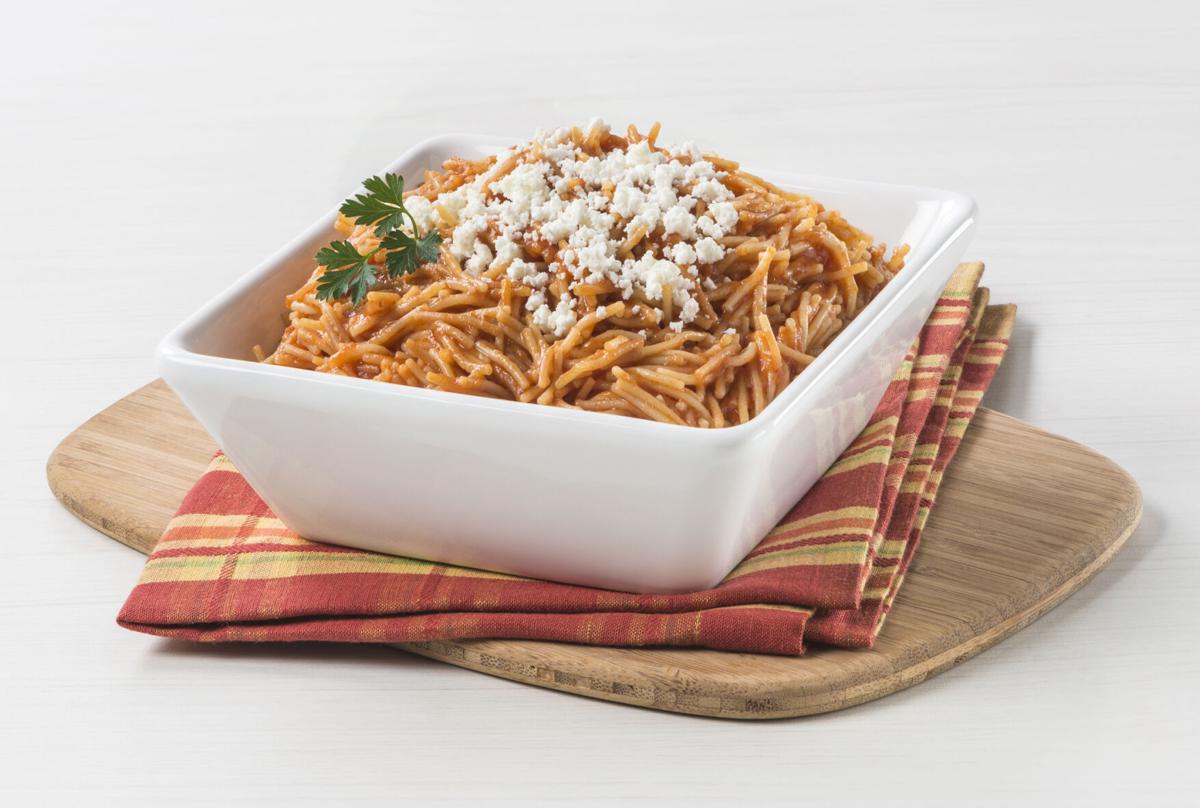Every language has its fair share of oxymorons — an expression that puts two contradictory words alongside each other. A famous one in English is “jumbo shrimp,” for example.
My favorite oxymoron is the name of a lovely, easy-to-prepare Mexican dish of vermicelli stewed in a flavorful sauce of puréed vegetables and chiles called sopa seca de fideo.
Sopa seca translates to “dry soup” and it makes me laugh every time I prepare it. I can’t figure out why, to the Mexican Spanish speaker, this dish resembles soup in any way, even though I understand that the phrase is used to describe a dish that’s barely saucy.
The first time I saw sopa seca prepared was on a business trip to Chiapas, shadowing chef Rick Bayless as he led a culinary tour through that state. He prepared a specialty of the state, sopa seca de pan — a brothy soup of vegetables transformed at the end by the addition of stale bread which soaked up the flavorful broth. It was a wonder — such simple ingredients, such a marvelous dish.
But the sopa seca I prepare most commonly at home is an even more humble supper — fideo (vermicelli noodles) cooked in an intensely flavored broth until they absorb its flavors. Sopa de fideo qualifies as a sopa seca, at least the way I make it, because by the end of cooking, there’s virtually no liquid left.
I think that it’s usually considered a side dish by Mexican cooks, but I find that a bowl with lots of garnishes — avocado, crema, red onion, cilantro — can stand alone as an entrée. If I have leftover cooked steak or beef, pork, or chicken, I might add a little as an additional garnish. More commonly, however, I eat it as a meatless meal. Kids really like this, I’ve found.
Because the ingredients are so simple, it’s an important step to char the vegetables before puréeing, which intensifies their flavor.
Incidentally, toasting the noodles before cooking is an unusual step. My Armenian friends taught me to do this before preparing their version of pilaf, which is the dish on which Rice-a-roni is based.
The Mexicans may have learned about fideo from the Spanish and Italian priests who were stationed in Mexico, but I’m not sure how the step of toasting the fideo arrived in the recipe.
I guess I’ll ponder that some more the next time I make this.
Sopa seca de fideo
Makes 6 servings
Mexican cooks often use chicken bouillon cubes instead of canned or homemade stock, so feel free to do that. You’ll need less salt at the end, as the bouillon cubes are quite salty in themselves. Two bouillon cubes dissolved in 1½ cups water makes an extra chicken-y stock.
Ingredients
2 medium large tomatoes, about 16 ounces total
1/2 of a medium-sized white onion
2 large garlic cloves
2 ancho chiles (or 1 chipotle pepper in adobo)
1½ tablespoon olive oil
7 to 8 ounces vermicelli noodles (sold as fideo in Mexican groceries)
1½ cups chicken broth (or 2 chicken bouillon cubes dissolved in 1½ cups hot water)
1 teaspoon dried oregano
1 teaspoon ground cumin
Salt to taste
Garnishes:
Mexican queso anejo, cotija or fresco
Mexican crema or sour cream thinned slightly with milk
Sliced avocado
Chopped cilantro
Thinly sliced red onion
Preparation
Heat a cast iron comal or a large skillet over medium heat. Char the tomatoes, white onion, garlic and ancho chiles on all sides (If you’re using chipotle, we’ll add that later). As the vegetables finish, remove them to a plate and set aside to cool.
When the vegetables have cooled, peel the onion and garlic. Remove the stem and seeds of the ancho chiles. Add the tomatoes, onion, garlic and chiles to the container of a blender.
If you’re using chipotle, add that to the blender container now. Whiz until the mixture is a thick, smooth puree. Set aside.
In a large skillet over medium heat, heat the olive oil. When it is fragrant, about 2 minutes, add the vermicelli and cook, stirring, until the noodles are golden brown. Add the chicken broth, the contents of the blender, the oregano, and the cumin, and cook, stirring occasionally, until the noodles soften, about 15 minutes.
If the noodles haven’t absorbed all the liquid, remove the skillet from the heat and set aside for a few minutes so the noodles can finish absorbing the liquid. Taste and add salt if necessary.
To serve, spoon a portion of the noodles into a bowl. Add crumbled cheese, crema, sliced avocado, chopped cilantro and sliced red onion as desired.





